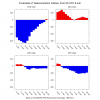John1122
Member
Yeah, the Arctic blast of January 2018 gave me low of 2 above with no snowcover. Thirty miles to our east had 3 inches on the ground and got down to minus 3.
Same event I'm talking about I'm sure. Here in Tennessee it turned cold on Christmas day December 2017 and stayed cold to very cold into January. It was cold and dry for the first 8 days of the month highs in the upper 10s and lower 20s. We had lows of 1, 0 and 3 nights below 0 in that time frame. We had a trace of snow in the 15 day period from December 25th to Jan 8th. 14 of the 15 days
saw 0.00 precip.
If finally got to 33 on January 9th and to add insult to injury, it rained.





















